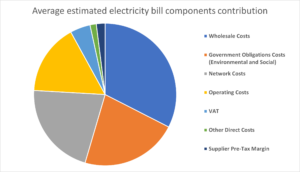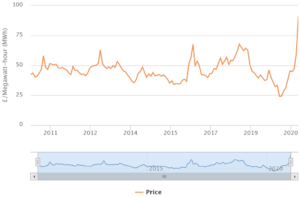Electricity Bill Charges
Learning the electricity bill charges basics and their price variations can be useful for finding opportunities to reduce your electricity costs expenses. In this section, you will find useful explanations, from the basics to a more detailed breakdown of the bill charge components.
Navigate through the main topics:
The Basics
The UK electricity bills are bespoke to each consumer because their components depend on geographical location, amount of energy consumed, type of tariff and the payment method.
In a high-level overview, the UK electricity bill can be broken down into 3 main components:
- Wholesale costs (commodity price)
- Network costs (transmission and distribution charges)
- Government obligations (environmental and social tariffs)
Using 2020 data provided by Ofgem, here is an average estimate of the proportional cost of each electricity bill charge component for domestic consumers, which is a reasonable comparison considering the proportion of the components for non-domestic consumers, as the same charges are applied for both. It can be seen that the 3 main components mentioned above account for almost 80% of the electricity bill costs.

The operating costs, other direct costs and supplier pre-tax margin are costs related to the retail energy suppliers business (Ofgem’s terms explanation can be accessed here), which depend on each business strategy. These costs and the VAT are relatively small compared to the other components, so they are not considered in the explanations here or this project’s analysis and API.
Interested to know more about the electricity bill components breakdown?
Components Breakdown
Wholesale/Commodity Cost
The wholesale or commodity component is the cost that suppliers have for purchasing electricity in advance in the wholesale market to supply their customers. The wholesale cost is the most volatile component of the electricity bill and its price changes are especially related to seasonal/weather conditions and gas prices (due to the marginal presence of gas-fired generation plants in the UK fuel mix).
The figure below shows the commodity day-ahead monthly average electricity prices (£/MWh) from 2010 to 2020. The day-ahead prices are a good indication of the short-term commodity price, however, suppliers usually buy their electricity months/years in advance, so the actual electricity price that a customer is charged is not exactly reflected by these prices.

Network Costs
The network costs are the components associated with the operation and maintenance of the electrical grid, which transports and delivers the electricity to consumers. These charges are collected by suppliers from customers and then transferred to network operators. Network company revenues and charges are regulated by Ofgem, the energy market regulator.
Network costs are classified into:
The TNUoS is charged to recover the costs to build, maintain, operate and improve the transmission system.
For Non-half hourly (NHH) consumers, TNUoS is calculated based on average energy consumption between 4 pm and 7 pm. For HH consumers, it is calculated based on peak consumption during Triad periods (three peaks of highest demand verified by National Grid ESO during November to February). TNUoS accounts for 7-10% of the total costs of the bill.
The DUoS is charged to recover the costs of operating the distribution system. DUoS charge has 4 components: unit charge, fixed charge, capacity charge and reactive power charge. DUoS accounts for about 12-15% of the total bill.
The most relevant DUoS component is the unit charge, which is charged based on specific day type (weekday or weekend) and time bands (Green, Amber, and Red). An example of this differentiation of rates is presented in the figures below using 2020 data from the DNO London Power Networks. It can be seen that the DUoS unit rate increases substantially during the red period.

With some electricity bill components having based calculations or having higher rates during the peak period, non-domestic consumers should avoid having a high demand during these peak hours.
There are 3 other network costs within the grid operation:
BSUoS considers the daily costs associated with the balancing of electricity generation and consumption. BSUoS represents approximately 3% of the total bill.
Tloss and Dloss account for the inherent losses that occur while the electricity is being transmitted through the grid. Tloss accounts for around 1% and Dloss around 3% of the total bill.
AAHEDC is charged to support areas with high distribution costs compared to the rest of the UK. The AAHEDC cost is negligible compared to the other bill cost components.
Government Obligations (environmental and social tariffs)
The government obligations are composed of environmental and social tariffs to support the decarbonisation of the electricity sector; there are five tariffs:
The RO scheme was one of the first policy mechanism to support the deployment of renewable energy by forcing suppliers to buy Renewable Obligation Certificates (ROCs). Although no longer active, RO payments are still ongoing. RO costs can represent 15-20% of the total bill.
Introduced to promote small scale renewable generators projects. FiT costs can represent 5-6% of the total bill.
Established to substitute the RO scheme to make renewable generators payments more predictable and stable. CfD costs represent 8% of the bill.
Established to secure future electricity supply, while promoting renewable investments. CM charge is levied during winter weekdays from 4 pm to 7 pm. CM costs represent 2% of the total bill.
The CCL is an environmental tax for businesses that use heat and electricity to incentive them to reduce their energy consumption and emissions. CCL electricity costs represent 7-8% of the total bill.
The estimated values for each electricity bill charge component for the network costs and government obligations cited were taken from the article (Acha et al., 2016).
Want to know more about your electricity costs and participate in our project?
We are looking for non-domestic energy consumers to engage with our online resources, provide ideas, feedback and become more energy aware in this complex and dynamic energy context!